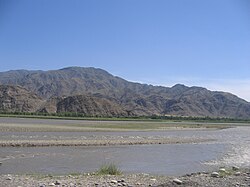Chitral River
| Chitral River Kunar | |
|---|---|
 | |
 Course of the Chitral River | |
| Location | |
| Countries | PakistanandAfghanistan |
| Provinces | Khyber Pakhtunkhwa(Pakistan) (Afghanistan) |
| Physical characteristics | |
| Source | Hindu KushMountains in Chitral |
| Mouth | Kabul River |
• location | Jalalabad |
| Length | 480 km (300 mi) |
| Basin size | 26,000 km2(10,000 sq mi) |
| Basin features | |
| Tributaries | |
| • left | Shishi River |
| • right | Lotkoh River,Landai Sin River,Pech River |
TheChitral River,[a]also known inAfghanistanas theKunar River,[b]is a 480 kilometres (300 mi) long river innorthern Pakistanand eastern Afghanistan. It originates from the Chiantar glacier, located at the border ofGilgit BaltistanandChitralwhich falls within theKhyber Pakhtunkhwaprovince of Pakistan. AtAranduit enters into Afghanistan, where it is named as the Kunar River.[1]It later merges withKabul riverin theNangahar Provinceof Afghanistan. The river system is fed by meltingglaciersandsnowof theHindu Kushmountains. The Chitral River serves as a major a tributary of the Kabul river, which is in turn a tributary of theIndus River.[2]
Origin and course of flow
[edit]The river rises in the far north glaciatedHindu Kushmountains ofChitral,Pakistan, where it is referred to as Chitral river.[3]Around 60% to 70% of annual discharge of Kunar river originates from Chitral.[4]Downstream as far as the town ofMastuj,it is called as the Mastuj river, till its confluence with the Lotkoh river.[5]Kunar then turns southwards into the upperKunar Valleyof Afghanistan. At the confluence inAsadabad,it meets withPech Riverand finally empties into theKabul Riverjust to the east of the city ofJalalabadin Afghanistan.[3]The combined rivers then flow eastwards into Pakistan again, and joins theIndus Riverat the city ofAttock.[3]

See also
[edit]References
[edit]- ^Nibanupudi, Hari Krishna; Shaw, Rajib (2014).Mountain Hazards and Disaster Risk Reduction.Japan: Springer. p. 37.ISBN978-4-431-55242-0.
- ^The Afghan War, 1838-1842: From the Journal and Correspondence of the Late Major-General Augustus Abbott,editorCharles Rathbone Low,publisher R. Bentley & Son, 1879,Google Books
- ^abcAhmad, Mahmood (2023-09-26).Water Policy in Pakistan: Issues and Options.Springer Nature. p. 327.ISBN978-3-031-36131-9.
- ^Watto, Muhammad Arif; Mitchell, Michael; Bashir, Safdar (2021-03-25).Water Resources of Pakistan: Issues and Impacts.Springer Nature. p. 45.ISBN978-3-030-65679-9.
- ^Pakistan & the Karakoram.Lonely Planet.2008. p. 233.ISBN9781741045420.
Further reading
[edit]- Allan, Nigel J. R.; Buddruss, Georg (1991)."CHITRAL".Encyclopaedia Iranica, Vol. V, Fasc. 5.pp. 487–494.
